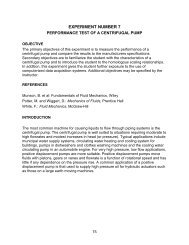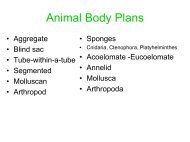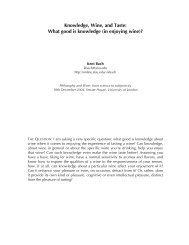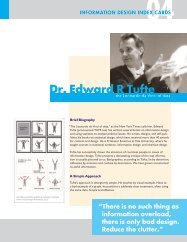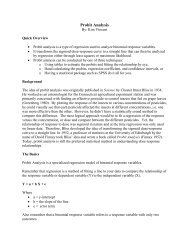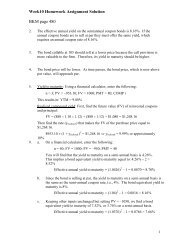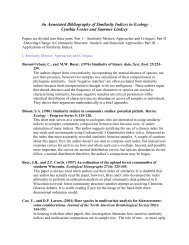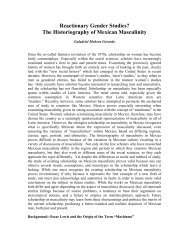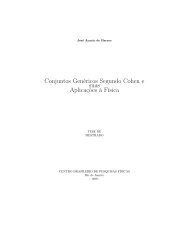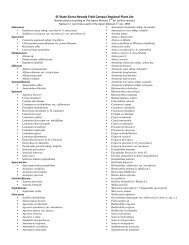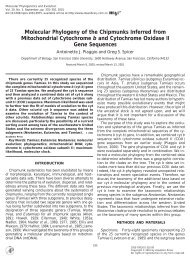SystemVerilog Verification Methodology Manual (VMM)
SystemVerilog Verification Methodology Manual (VMM)
SystemVerilog Verification Methodology Manual (VMM)
Create successful ePaper yourself
Turn your PDF publications into a flip-book with our unique Google optimized e-Paper software.
System Verilog <strong>Verification</strong><br />
<strong>Methodology</strong> <strong>Manual</strong><br />
(<strong>VMM</strong> 1.2)<br />
Developed By<br />
Abhishek Shetty<br />
Guided By<br />
Dr. Hamid Mahmoodi<br />
Nano-Electronics & Computing Research Center<br />
School of Engineering<br />
San Francisco State University<br />
San Francisco, CA<br />
Spring 2012
Table of Contents<br />
1. Object Oriented Language Basics ..................................................................... 3<br />
2. Layered <strong>Verification</strong> Environment ................................................................... 4<br />
3. <strong>VMM</strong> Guiding Principles .......................................................................... 6<br />
4. Transactor Phasing ...................................................................................... 7<br />
4.1 Explicit Phasing .......................................................................... 9<br />
4.2 Implicit Phasing .......................................................................... 10<br />
5. Transactor Callbacks ...................................................................................... 13<br />
6. Scenario Generators ...................................................................................... 14<br />
7. Creating Testbench Essential Elements .................................................. 16<br />
7.1 Transactor Class ...................................................................................... 17<br />
7.2 Scoreboard Class ...................................................................................... 24<br />
7.3 Coverage Class ...................................................................................... 18<br />
7.4 Message Service ...................................................................................... 26<br />
7.5 Creating Tests ...................................................................................... 27<br />
8. Hands on creating of <strong>VMM</strong> testbench elements ...................................... 28<br />
9. Example DUT .................................................................................................. 30<br />
10. Accessing examples from the Hafez server .................................................. 36<br />
11. References & Books ...................................................................................... 36<br />
2
1. Object Oriented Language Basics<br />
Inheritance<br />
- New classes derived from original base class<br />
- Inherits all contents of base class<br />
- Keyword extends used to inherit base class features<br />
class My_Packet extends Packet<br />
Packet<br />
MyPacket<br />
To over-ride the functionality of the compute_crc in MyPacket extended class, keyword super is<br />
used to override the behavior from base class.<br />
Packet P1;<br />
My_Packet P2;<br />
P1.compute_crc ();<br />
P2.compute_crc ();<br />
function void display();<br />
.....<br />
endfunction<br />
function int compute_crc();<br />
.....<br />
endfunction<br />
function int compute_crc();<br />
crc = super.compute_crc();<br />
.....<br />
endfunction<br />
When a method within the scope of the object is declared to be virtual, then the last definition of<br />
the method in the object’s memory will be executed.<br />
3
Polymorphism<br />
The objects of the class inherit the properties and transfer it over to the other<br />
objects.<br />
class protocol;<br />
....<br />
task transmit(Packet pkt);<br />
......<br />
....pkt.crc = pkt.compute_crc();<br />
.....<br />
endtask<br />
endclass<br />
2. Layered <strong>Verification</strong> Environment<br />
4<br />
protocol bfm = new(...);<br />
repeat (100) begin<br />
Packet p = new();<br />
bfm.transmit(p);<br />
end<br />
class Packet<br />
compute_crc();<br />
pkt
The DUT initiates the transaction and the reactive driver supplies the required data to<br />
successfully complete the transaction. For example, a program memory interface bus-functional<br />
model is a reactive driver. The DUT initiates read cycles to fetch the next instruction and the<br />
bus-functional model supplies new data in the form of an encoded instruction.<br />
The term Transactor is used to identify components of the verification environment that<br />
interface between two levels of abstraction for a particular protocol or to generate protocol<br />
transactions. In above figure, the boxes labeled Driver, Monitor, Checker and Generator are all<br />
transactors. The lifetime of transactors is static to the verification environment.<br />
They are structural components of the verification components and they are similar to the DUT<br />
modules. A driver actively supplies stimulus data to the DUT. A proactive driver is in control of<br />
the initiation and type of the transaction.<br />
A monitor reports observed high-level transaction timing and data information. A<br />
reactive monitor includes elements to generate the low-level handshaking signals to terminate an<br />
interface and successfully complete a transaction.<br />
Both transactors and data are implemented using the class construct. The difference between a<br />
Transactor class and a data class is their lifetime. Limited number of Transactor instances is<br />
created at the beginning of the simulation and they remain in existence throughout. This creates a<br />
very large number of data and transaction descriptors instances throughout the simulation and<br />
they have a short life span.<br />
Eg: Transactor Declarations<br />
class mii_mac_layer extends vmm_xactor;<br />
...<br />
endclass: mii_mac<br />
The vmm_xactor base class contains standard properties and methods to configure and control<br />
transactors. To ensure that all transactors have a consistent usage model, you must derive them<br />
from a common base class.<br />
5
3. <strong>VMM</strong> Guiding Principles<br />
- Top-down implementation methodology<br />
• Emphasizes “Coverage Driven <strong>Verification</strong>”<br />
- Maximize design quality<br />
• More testcases<br />
• More checks<br />
• Less code<br />
- Approaches<br />
a. Reuse<br />
o Across tests<br />
o Across blocks<br />
o Across systems<br />
o Across projects<br />
b. One verification environment, many tests<br />
c. Minimize test-specific code<br />
<strong>VMM</strong> Base Classes and Macros<br />
Base Classes<br />
vmm_test<br />
vmm_group<br />
vmm_data<br />
vmm_xactor<br />
vmm_tlm<br />
vmm_env<br />
vmm_subenv<br />
Class Libraries<br />
vmm_log<br />
vmm_opts<br />
vmm_notify<br />
vmm_broadcast/scheduler<br />
vmm_ms_scenario_gen/vmm_ms_scenario<br />
Class Macros<br />
vmm_channel<br />
vmm_atomic_gen<br />
vmm_scenario_gen<br />
6
Code Macros<br />
vmm_member_begin/end<br />
vmm_callback<br />
vmm_fatal<br />
vmm_error<br />
vmm_warning<br />
vmm_note<br />
vmm_trace<br />
vmm_debug<br />
vmm_verbose<br />
vmm_unit_config<br />
vmm_rtl_config<br />
The above listings are the collection of classes and macros most commonly used. The full listing<br />
of all available classes and macros are found in <strong>VMM</strong> Standard Library User Guide.<br />
4. Transactor Phasing<br />
Transactors progress through a series of phases throughout simulation. All transactors are<br />
synchronized so that they execute their phases synchronously with other transactors during<br />
simulation execution.<br />
<strong>VMM</strong> supports two levels of Transactor phasing, implicit and explicit phasing. During<br />
explicit phasing, all the transactors are controlled by the master controller such as vmm_env to<br />
call the Transactor phases. In implicit phasing, the transactors execute their phases automatically<br />
and synchronously.<br />
In an implicitly phased testbench, functions and tasks representing phases are called<br />
automatically at the appropriate times. A global controller (vmm_simulation) works in<br />
conjunction with specially configured schedulers (vmm_timeline) to walk all testbench<br />
components through relevant phases. vmm_simulation acts like a conductor, keeping all of the<br />
various testbench components in sync during pre-test, test, and post-test portions of a typical<br />
simulation.<br />
7
Explicit Phase Implicit Phase Intended Purpose<br />
gen_cfg rtl_config<br />
gen_config<br />
8<br />
Determine configuration of<br />
the testbench<br />
build build Create the testbench<br />
configure Configure options<br />
connect Connect TLM interfaces,<br />
channels<br />
configure_test_ph Test specific changes<br />
start_of_sim Logical start of simulation<br />
Reset reset Reset DUT<br />
cfg_dut config_dut Configuration of the DUT<br />
start start Logical start of the test<br />
start_of_test Physical start of test<br />
wait_for_end run Body of test, end of test<br />
detection to be done here<br />
stop shutdown Stop flow of stimulus<br />
Cleanup Cleanup Let DUT drain and read final<br />
DUT state<br />
Report Report Pass/Fail report (executed by<br />
each test)<br />
Final Final checks and actions<br />
before simulation termination<br />
Explicit Transactor Phasing, transactors begin to execute when the environment explicitly calls<br />
vmm_xactor :: start_xactor to start the Transactor. This then starts the vmm_xactor :: main<br />
thread.<br />
Eg: Extension of vmm_xactor :: main() task<br />
task mii_mac_layer :: main();<br />
fork<br />
super.main ();<br />
join_none<br />
...<br />
endtask: main
Eg: Modeling Transactor<br />
class my_vip extends vmm_xactor;<br />
`vmm_typename(my_vip)<br />
Function new(string name = "", vmm_object parent = null);<br />
super.new("vip", name);<br />
super.set_parent_object(parent);<br />
endfunction<br />
virtual function void start_xactor();<br />
super.start_xactor ();<br />
`vmm_note(log, "Starting...");<br />
endfunction<br />
virtual function void stop_xactor();<br />
super.stop_xactor ();<br />
`vmm_note(log, "Stopping...");<br />
endfunction<br />
‘vmm_class_factory(my_vip)<br />
endclass<br />
4.1 Explicit Phasing<br />
Eg: Creation of Explicitly Phased Environment<br />
class my_env extends vmm_env;<br />
`vmm_typename(my_env)<br />
my_subenv subenv1;<br />
my_subenv subenv2;<br />
function new ();<br />
super.new("env");<br />
endfunction<br />
virtual function void build();<br />
super.build ();<br />
this.subenv1 = new ("subenv1", this);<br />
this.subenv2 = new ("subenv2", this);<br />
endfunction<br />
virtual task start ();<br />
super.start();<br />
`vmm_note(log, "Started...");<br />
this.subenv1.start();<br />
this.subenv2.start();<br />
endtask<br />
virtual task wait_for_end ();<br />
9
endclass<br />
super.wait_for_end();<br />
`vmm_note(log, "Running...");<br />
#100;<br />
endtask<br />
virtual task stop ();<br />
super.stop();<br />
`vmm_note (log, "Stopped...");<br />
this.subenv1.stop();<br />
this.subenv2.stop();<br />
endtask<br />
Note: ‘Super’ keyword is being used to enable calling the methods from the base class instead of<br />
derived class with same method names<br />
Eg: Creation of Explicitly Phased Test using above Environment<br />
`vmm_test_begin (test, my_env, "Test")<br />
env.run();<br />
`vmm_test_end(test)<br />
Eg: Top Program to use the above test and environment<br />
program top;<br />
initial<br />
begin<br />
my_env env = new;<br />
vmm_test_registry::run(env);<br />
end<br />
endprogram<br />
4.2 Implicit Phasing<br />
In the implicit phasing execution model, transactors are self-controlled through built-<br />
in phasing mechanism. The environment automatically calls the phase specific methods in a top<br />
down, bottom up and forked fashion.<br />
Implicit phasing works only with transactors that you base on the vmm_group or<br />
vmm_xactor class. The two use models are,<br />
- If you want to call your Transactor phases from the environment, you should instantiate<br />
your vmm_xactor(s) in vmm_env or vmm_subenv.<br />
- If you want to have the environment implicitly calling Transactor phases, you should<br />
instantiate your vmm_xactor(s) in vmm_group.<br />
Implicit phasing works only with classes that you base on the vmm_group class.<br />
10
Eg: Creation of Implicitly Phased Sub-Environment<br />
class my_subenv extends vmm_group;<br />
endclass<br />
`vmm_typename(my_subenv)<br />
my_vip vip1;<br />
my_vip vip2;<br />
function new(string name = "", vmm_object parent = null);<br />
super.new("vip", name, null);<br />
super.set_parent_object(parent);<br />
endfunction<br />
virtual function void build_ph();<br />
super.build_ph();<br />
this.vip1 = new("vip1", this);<br />
this.vip2 = new("vip2", this);<br />
endfunction<br />
virtual task start_ph();<br />
super.start_ph();<br />
`vmm_note(log, "Started...");<br />
endtask<br />
Eg: Creation of Implicitly Phased Environment<br />
class my_env extends vmm_group;<br />
`vmm_typename(my_env)<br />
my_subenv subenv1;<br />
my_subenv subenv2;<br />
function new();<br />
super.new("env");<br />
endfunction<br />
virtual function void build_ph();<br />
super.build_ph();<br />
this.subenv1 = new("subenv1", this);<br />
this.subenv2 = new("subenv2", this);<br />
endfunction<br />
virtual task start_ph();<br />
super.start_ph();<br />
`vmm_note(log, "Started...");<br />
endtask<br />
virtual task run_ph();<br />
super.run_ph();<br />
`vmm_note(log, "Running...");<br />
#100;<br />
endtask<br />
virtual task shutdown_ph();<br />
11
endclass<br />
endtask<br />
super.shutdown_ph();<br />
`vmm_note(log, "Stopped...");<br />
Eg: Creation of Implicitly Phased Test using above sub_env and env<br />
class test extends vmm_test;<br />
endclass<br />
function new();<br />
super.new("Test");<br />
endfunction<br />
virtual task start_ph();<br />
super.start_ph();<br />
`vmm_note(log, "Started...");<br />
endtask<br />
virtual task shutdown_ph();<br />
super.shutdown_ph();<br />
`vmm_note(log, "Stopped...");<br />
endtask<br />
Transactors are started during specific phases (not necessarily at start), run during a<br />
certain number of phases. Environment can suspend their execution thread and resume it and<br />
might stop it during another phase.<br />
The vmm_xactor class is the base class for transactors. It provides thread management<br />
utilities (start, stop, reset_xactor, wait_if_stopped) that are not present in the other base classes.<br />
The vmm_xactor offers both thread management and phase methods. It is important to<br />
understand to properly model transactors and how you model different behaviors at different<br />
phases. The simplest form for a Transactor is one whose behavior does not change between<br />
simulation phases. If you instantiate this Transactor in an implicitly phased environment, then it<br />
gets started by default.<br />
12
5. Transactor Callbacks<br />
Callback methods to monitor the data flowing through a Transactor to check for<br />
correctness inject errors or collect functional coverage metrics. You can adapt the Transactor<br />
callbacks to the needs of testcase or environment. Callback should be registered in the<br />
vmm_xactor base class. However, calling the registered callback extensions is the responsibility<br />
of the Transactor extended from the base class.<br />
Transactor Callbacks Usage<br />
- Create a callback class with empty virtual methods<br />
- Each virtual method represents an important stage of Transactor.<br />
- The arguments of the virtual methods should contain necessary information that can be<br />
shared with the subscribers.<br />
Eg 1 : class cpu_driver_callbacks extends vmm_xactor_callback;<br />
virtual task pre_trans (cpu_driver driver, cpu_trans tr, ref bit drop);<br />
endtask<br />
virtual task post_trans (cpu_driver driver, cpu_trans tr);<br />
endtask<br />
endclass<br />
- At every important stage in the Transactor, call the corresponding method declared above<br />
through `vmm_callback macro.<br />
Eg 2: class cpu_driver extends vmm_xactor;<br />
virtual protected task main();<br />
super.main();<br />
……<br />
`vmm_callback(cpu_driver_callbacks, pre_trans(this, tr, drop));<br />
if (tr.kind == cpu_trans::WRITE) begin<br />
write_op(tr);<br />
end<br />
if (tr.kind == cpu_trans::READ) begin<br />
read_op(tr);<br />
end<br />
13
`vmm_callback(cpu_driver_callbacks, post_trans(this, tr));<br />
endtask<br />
endclass<br />
- A subscriber extends the callback class, fill the necessary empty virtual methods.<br />
Eg 3: class cpu_sb_callback extends cpu_driver_callbacks;<br />
cntrlr_scoreboard sb;<br />
function new(cntrlr_scoreboard sb);<br />
this.sb = sb;<br />
endfunction<br />
virtual task pre_trans(cpu_driver drv, cpu_trans tr,ref bit drop);<br />
sb.cpu_trans_started(tr);<br />
endtask<br />
virtual task post_trans(cpu_driver drv, cpu_trans tr);<br />
sb.cpu_trans_ended(tr);<br />
endtask<br />
endclass<br />
- Register the subscriber callback class using method vmm_xactor::append_callback.<br />
- Then every time Transactor hits the defined important stages, subscriber methods will be<br />
called. Note that any number of subscribers with their own definition of virtual methods<br />
can get registered to a Transactor.<br />
Eg 4: class cntrlr_env extends vmm_group;<br />
cpu_driver drv;<br />
virtual function void connect_ph();<br />
cpu_sb_callback cpu_sb_cbk = new(sb);<br />
cpu_cov_callback cpu_cov_cbk = new(cov);<br />
drv.append_callback(cpu_sb_cbk);<br />
drv.append_callback(cpu_cov_cbk);<br />
endfunction<br />
endclass<br />
6. Scenario Generators<br />
- <strong>VMM</strong> provides a scenario macro to build most of the scenario code<br />
- Customize for your own needs by adding own constraints and scenario selection rules<br />
Eg: `vmm_scenario_gen (transaction_class, scn_gen_name)<br />
`vmm_scenario_gen (atm_cell, “ATM Scn Gen”)<br />
14
1. Scenario Generator mainly contains<br />
- 1 or more scenario classes<br />
- Scenario selection class<br />
Scenario Class will be derived from the transaction_scenario class and the scenario base class is<br />
defined by the macro.<br />
2. Scenario Class contains<br />
- one or more scenarios selected by scenario_kind<br />
- Constraints to direct each scenario. Each scenario must be constrained with length and counter<br />
- apply() task - send the scenario to an output channel<br />
Eg: Creating a Scenario<br />
class my_scenario extends atm_cell_scenario<br />
`vmm_typename(my_scenario)<br />
int unsigned INC_VPI; // Scenario kind must be defined<br />
constrained inc_vpi_scenario {<br />
($void(scenario_kind) == INC_VPI) -> {<br />
length == 5;<br />
repeated == 0;<br />
foreach (items[i])<br />
if (i > 0) items[i].vpi == items[i-1].vpi+1;<br />
}<br />
}<br />
function new ();<br />
this. INC_VPI = define_scenario (“Inc VPI”, 5);<br />
...<br />
endfunction<br />
...<br />
`vmm_class_factory(my_scenario)<br />
endclass<br />
Registering Scenarios<br />
1. Adding Scenario Objects to Scenario Set<br />
Eg: my_scenario my_scn = new( );<br />
env.scn_gen.scenario_set.push_back(my_scn); //Add a new scenario<br />
Eg: my_scenario my_scn = new( );<br />
env.scn_gen.scenario_set[0] = my_scn; // Replacing default atomic scenario<br />
15<br />
Scenario<br />
Constraint
Structural<br />
Class<br />
Behavioral<br />
Class<br />
Self-Checking<br />
Class<br />
2. Multistream Scenario<br />
Eg: task my_ms_scenario :: execute ( ref int n );<br />
vmm_channel to_ahb = get_channel (“AHB”);<br />
vmm_channel to_eth = get_channel (“ETH”);<br />
if (!this.ahb.randomize() )<br />
`vmm_fatal ( log, “ahb randomization failed”);<br />
do begin<br />
to_ahb.put (this.ahb);<br />
end while ( this.ahb.status != ahb_cycle :: IS_OK );<br />
to_eth.put(this.eth);<br />
n++;<br />
endtask<br />
7. <strong>VMM</strong> Testbench Essential Elements<br />
Test Class<br />
(i) Test Class: vmm_test<br />
(ii) Structural Class: vmm_group<br />
(iii) Behavioral Class: vmm_xactor<br />
Generator<br />
vmm_simulation:: run_tests()<br />
(iv) Communication Class: vmm_channel (Eg: communication between Generator and Master)<br />
16<br />
Coverage Configure<br />
Master Self Check Slave<br />
Interface<br />
DUT
There are three general categories of Transactors. Master, Slave and Monitors. All of these will<br />
be built by extending from the vmm_xactor base class.<br />
Below are the examples of different types of transactors.<br />
Creating Transaction Classes<br />
All transactions extend<br />
class Packet extends vmm_data;<br />
from vmm_data<br />
rand bit [3:0] sa, da;<br />
rand bit [7:0] payload[$];<br />
int active_sa[$], active_da[$];<br />
constraint valid {<br />
payload.size inside { [1:1024]};<br />
sa inside active_sa; da inside active_da;<br />
}<br />
`vmm_data_member_begin(Packet)<br />
`vmm_data_member_scalar(sa, DO_ALL)<br />
`vmm_data_member_scalar(da, DO_ALL)<br />
`vmm_data_memeber_scalar_array(payload, DO_ALL)<br />
`vmm_data__member_scalar_array(active_sa, DO_COPY)<br />
`vmm_data_member_scalar_array(active_da, DO_COPY)<br />
`vmm_data_member_end(Packet)<br />
endclass<br />
Creating Master Transactor Class<br />
class master extends vmm_xactor;<br />
vmm_channel_typed # (Packet) in_chan;<br />
function new (string inst, int stream_id, vmm_object parent);<br />
super.new (“master”, inst, stream_id, parent);<br />
end function<br />
protected task main ();<br />
super.main();<br />
forever begin<br />
Packet tr;<br />
this.wait_if_stopped_or_empty (this.in_chan);<br />
this.in.chan.activate(tr);<br />
this.send(tr);<br />
this.in.chan.remove();<br />
end<br />
endtask<br />
endclass<br />
17<br />
All transactors extend<br />
from vmm_xactor
A typical Master Transactor waits for a transaction (typically passed in via a typed channel) to<br />
process.<br />
Creating Slave Transactor Class<br />
class save extends vmm_xactor;<br />
function new (string inst, int stream_id, vmm_object parent);<br />
super.new (“slave”, inst, stream_id, parent);<br />
endfunction<br />
protected task main() ;<br />
super.main ();<br />
forever begin<br />
Packet tr;<br />
this.recv(tr);<br />
end<br />
endtask<br />
endclass<br />
Note: Slave transactors are infinite loops in main () emulating capture flop.<br />
A slave Transactor class calls a physical layer device driver method to actively<br />
handshake with the DUT and reconstructs the transaction received from the DUT. If there is a<br />
passive monitor built in the testbench then the reconstructed transaction should be discarded. If<br />
no passive monitor exists on the interface then the reconstructed transaction should be passed to<br />
a scoreboard via either a channel or callback mechanism.<br />
Creating Monitor Transactor Class<br />
class imonitor extends vmm_xactor;<br />
function new (string inst, int stream_id, vmm_object parent);<br />
super.new(“monitor”, inst, stream_id, parent);<br />
endfunction<br />
protected task main();<br />
super.main();<br />
forever begin<br />
Packet tr;<br />
this.get_input_packet(tr);<br />
this.inp_vmm_sb_ds(tr);<br />
end<br />
endtask<br />
18
class omonitor extends vmm_xactor;<br />
function new (....);<br />
super.new(....);<br />
endfunction<br />
protected task main();<br />
super.main();<br />
forever begin<br />
Packet tr;<br />
this.get_output_packet (tr);<br />
this.exp_vmm_sb_ds (tr);<br />
end<br />
endtask<br />
Passive Monitors are different from the Master and Slave transactors in that they only<br />
observe interface handshakes. They do not actively participate in the interface handshake.<br />
Passive monitors exist for two primary reasons: protocol check and reconstruction of transaction<br />
to be passed on to a scoreboard.<br />
The built-in methods, inp_vmm_sb_ds () and exp_vmm_sb_ds (), can be used to check the input<br />
transaction against the expected transaction.<br />
Creating Scoreboard Class<br />
Data stream scoreboard extends from vmm_sb_ds. The vmm_bs_ds base scoreboard<br />
class has compare methods built-in. It can be extended to incorporate additional user specific<br />
requirements.<br />
class scoreboard extends vmm_sb_ds;<br />
Packet pt;<br />
covergroup sb_cov;<br />
sa : coverpoint pkt.sa;<br />
da : coverpoint pkt.da;<br />
cross sa, da;<br />
endgroup<br />
function new (string name = “scoreboard”);<br />
super.new(name);<br />
sb_cov = new;<br />
endfunction<br />
function bit compare ( vmm_data actual, vmm_data expected )<br />
if ( super.compare(actual, expected) ) begin<br />
$cast (this.pkt, actual);<br />
this.sb_conv.sample();<br />
return;<br />
end<br />
return 0;<br />
endfunction<br />
19<br />
endclass
Creating Test Configuration Class<br />
class test_cfg;<br />
rand int run_for_n_packets;<br />
rand int num_of_iports, num_of_oports;<br />
rand bit iport[16], oport[16];<br />
constraint valid {<br />
run_for_n_packets inside {[1:1000]};<br />
num_of_iports inside {[1:16]};<br />
num_of_oports inside{[1:16]};<br />
iport.sum() == num_of_iports;<br />
oport.sum() == num_of_oports;<br />
}<br />
virtual function void display ( );<br />
endclass<br />
The configuration class is intended to define the parameters for a given testcase.<br />
Construct Testbench components<br />
class tb_env extends vmm_group<br />
vmm_atomic_gen # (Packet) gen;<br />
master dvr; slave rcv;<br />
imonitor imon; omonitor omon;<br />
scoreboard sb; test_cfg cfg;<br />
function new(string inst=””, vmm_object parent);<br />
super.new(“tb_env”, inst, parent);<br />
endfunction<br />
function void build_ph();<br />
gen = new(“gen”, 0, null, this);<br />
sb = new(“sb”);<br />
dvr = new(“dvr”, 0, this);<br />
rcv = new(“rcv”, 0, this);<br />
imon = new(“imon”,0, this);<br />
omon = new(“omon”, 0, this);<br />
cfg = new();<br />
endfunction<br />
........<br />
Configure and Connect Transactors<br />
1. Connect the components in connect_ph()<br />
2. Set test controls in start_of_sim_ph()<br />
3. Wait for consensus in run_ph()<br />
20
Run-Time Seeds Create Different Tests<br />
The ability to set random seed at run-time with +ntb_random_seed option is very useful for<br />
creating multiple reproduce-able tests with one simv.<br />
But user must pick and set the seed. An alternative can be +ntv_random_seed_automatic. With this<br />
option, the seed is randomly picked by vcs. Every run of the same simv binary will result in running<br />
simulation with a different seed. When using the run-time option, one must retrieve and store the seed<br />
being used with $get_initial_random_seed().<br />
The vmm_env base class automatically calls $get_initial_random_seed() and displays the random<br />
seed for you.<br />
The default seed if neither option is applied is 1.<br />
Develop a collection of Tests<br />
class all_ports extends vmm_test;<br />
function new(string name, doc);<br />
super.new (name, doc);<br />
endfunction<br />
function void configure_test_ph( );<br />
env.cfg.num_of_iports = 16;<br />
env.cfg.num_of_oports = 16;<br />
env.cfg.num_of_iports.rand_mode(0);<br />
env.cfg.num_of_opors.rand_mode(0);<br />
endfunction<br />
endclass<br />
all_ports test_all = new(“all_ports”, “Testing all ports”);<br />
class ten_packets extends vmm_test;<br />
function new(string name, doc);<br />
super.new(name, doc);<br />
endfunction<br />
function void configure_test_ph( );<br />
env.cfg.num_of_iports = 10;<br />
env.cfg.num_of_oports = 10;<br />
env.cfg.run_for_n_packets.rand_mode(0);<br />
endfunction<br />
endclass<br />
ten_packets test_ten_packets = new(“ten_packets”, “Small Test”);<br />
21
Execution of Tests:<br />
- At test top level:<br />
program automatic test;<br />
`include “tb_env.sv”<br />
`include “tests.inc”<br />
tb_env env = new();<br />
intial begin<br />
vmm_simulation :: list();<br />
vmm_simulation :: run_tests();<br />
end<br />
endprogram<br />
- simv command line:<br />
• ./simv +vmm_test = all_ports (These are name of the tests specified)<br />
• ./simv +vmm_test = ten_packets<br />
• ./simv +vmm_test = ALL_TESTS<br />
<strong>VMM</strong> Generators<br />
<strong>VMM</strong> has two types of generators. Atomic generator and Scenario generator.<br />
Atomic generator is a simple generator, which generates transactions randomly.<br />
`vmm_atomic_gen is a macro which is used to define a class named<br />
_atomic_gen for any user-specified class derived from vmm_data, using a process<br />
similar to the `vmm_channel macro.<br />
To use _atomic_gen class, a _channel must exist.<br />
_atomic_gen generates transactions and pushes it to _channel. A<br />
_channel object can be passed to generator while constructing.<br />
Lets create atomic generator for auto_packet class in file auto_packet.sv<br />
1. define `vmm_atomic_gen macro for packet class. This macro creates a packet_atomic_gen<br />
class creates and randomizes packet transactions.<br />
`vmm_atomic_gen(auto_packet,”packet atomic generator”)<br />
2. define `vmm_channel for the packet class. This macro creates a packet_channel, which will be<br />
used by the packet_atomic_gen to store the transactions. Any other component can take the<br />
transactions from this channel.<br />
`vmm_channel(auto_packet)<br />
3. Create an object of packet_atomic_gen.<br />
packet_atomic_gen pkt_gen = new ("Atomic Gen","test");<br />
22
4. Set the number of transactions to be generated to 4<br />
pkt_gen.stop_after_n_insts = 4;<br />
5. Start the generator to generate transactions. These transactions are available to access through<br />
pkt_chan as soon as they are generated.<br />
pkt_gen.start_xactor();<br />
6. Collect the packets from the pkt_chan and display the packet content to terminal.<br />
pkt_gen.out_chan.get(pkt);<br />
pkt.display();<br />
Factory Class Needs<br />
- Factories are blue print classes that generate objects of a specific kind<br />
- A factory should be able to generate objects of the specified class<br />
- Factories should also be able to generate customized transactions if specified at test case<br />
level<br />
Eg: Allocate new objects using a blueprint instance, via a virtual method<br />
class bfm extends vmm_xactor;<br />
transaction blueprint;<br />
....<br />
task build_ph();<br />
blueprint = new ();<br />
endtask<br />
protected task main();<br />
super.main();<br />
forever begin<br />
transaction tr;<br />
tr = blueprint.allocate ();<br />
...<br />
process(tr);<br />
end<br />
endtask<br />
endclass<br />
In above example for a factory design, we allocate from a single instance, via a virtual method,<br />
that is then stored in the local variable instead of allocating into local variable directly.<br />
In Factory class, we can replace a transaction by a derived class or we can replace a<br />
scenario by another scenario.<br />
23<br />
class transaction extends vmm_data;<br />
....<br />
virtual function vmm_data allocate;<br />
transaction txn = new();<br />
return txn;<br />
endfucntion<br />
endclass
Two ways of overriding factory<br />
[i] by copy() : replace existing factory by an object of same/derived instance with the values of<br />
the instance copied.<br />
[ii] by new () : replace existing factory by a new derived object.<br />
User doesn’t have to necessarily extend vmm_object or vmm_data to make use of factory<br />
service.<br />
Scoreboard<br />
- Self-checking testbenches need scoreboards.<br />
- Reusable scoreboards can be used for multiple testbenches.<br />
- Proper understanding of the DUT is necessary to design an efficient scoreboard.<br />
- Different score boarding mechanisms are used for different applications.<br />
Creating & Accessing Scoreboards<br />
- Use vmm_sb_ds macro<br />
- If the DUT behavior is single stream and no transformation, no extension to base class is<br />
Synatax<br />
required.<br />
//Extend vmm_sb_ds<br />
class my_sb extends vmm_sb_ds;<br />
.....<br />
endclass<br />
Eg: Use vmm_xactor’s scoreboard methods<br />
class bus_master extends vmm_xactor;<br />
.....<br />
`vmm_callback(bus_master_cb, post_tr(this, tr);<br />
this.inp_vmm_sb_ds (tr); // Add input packet<br />
endclass<br />
class bus_mon extends vmm_xactor;<br />
.....<br />
`vmm_callback (bus_mon_cb, post_tr (this, tr) ) ;<br />
this.exp_vmm_sb_ds (tr); // Check with expected packet<br />
endclass<br />
Connecting Scoreboard<br />
class my_env extends vmm_group;<br />
vmm_sb_ds sb;<br />
bus_master xtor_mstr;<br />
bus_mon xtor_mon;<br />
24
virtual function build_ph( );<br />
super.build ( );<br />
this.sb = new(...); // Creating Scoreboard<br />
this.xtor_mstr = new (...);<br />
this.xtor_mon = new (...);<br />
endfunction: build_ph<br />
virtual function connect_ph( )<br />
this.xtor_mstr.register_vmm_sb_ds (this.sb,<br />
vmm_sb_ds :: INPUT,<br />
vmm_sb_ds :: IN_ORDER) ;<br />
this.xtor_mon.register_vmm_sb_ds(this.sb,<br />
vmm_sb_ds :: EXPECT,<br />
vmm_sb_ds :: IN_ORDER);<br />
endfunction: connect_ph<br />
endclass<br />
Scoreboard Compares<br />
- In addition to vmm_data :: compare() the scoreboard has two compare functions<br />
- vmm_sb_ds :: quick_compare ( )<br />
Called by expect_with_losses () & vmm_sb_ds::compare()<br />
Minimal set of checks to identify unique matches<br />
May require calling vmm_data :: compare()<br />
Default behavior returns 1<br />
- vmm_sb_ds :: compare ( )<br />
Normal scoreboard compare routine<br />
Calls quick_compare ( ) followed by vmm_data :: compare ( )<br />
- Overload either of these functions or custom compares<br />
Scoreboard - Transformation<br />
Eg:<br />
- Specified via virtual method vmm_ds_sb :: transform ()<br />
- Transform can be one-to-one, one-to-many, many-to-one<br />
class ahb_to_ocp_sb extends vmm_sb_ds;<br />
virtual function bit transform ( input vmm_data in_pkt, output vmm_data out_pkts[] );<br />
ahb_tr in_tr;<br />
ocp_tr out_tr = new;<br />
$cast ( in_tr, in_pkt );<br />
//convert in_tr to out_tr. One-to-one transform<br />
out_tr = ..........<br />
out_pkts = new [1];<br />
25
out_pkts[0] = out_tr; // Fill the out packets array.<br />
endfunction<br />
endclass<br />
6.3 Message Service<br />
- Transactors. Scoreboards, assertions, environment and testcases use messages to report<br />
any definite or potential errors detected. They may also issue messages to indicate the<br />
progress of the simulation or provide additional processing information to help diagnose<br />
problems. A message service is only concerned with the formatting and issuance of<br />
messages, not their causes. For example, the time reported in a message is the time at<br />
which the message was issued, not the time a failed assertion started. The <strong>VMM</strong> message<br />
service uses the following concepts to describe and control messages.<br />
1. Message Source: Message source can be any component of a testbench. Messages from each<br />
source can be controlled independently of the message from other sources.<br />
2. Message Filters: Filters can prevent or allow a message from being issued. They are<br />
associated and disassociated with message sources. Message filters can promote or demote<br />
messages severities, modify message types and their simulation handling.<br />
3. Message Type: Individual messages are categorized into different types to issue the message.<br />
Eg: vmm_log :: FAILURE_TYP => An error has been detected.<br />
vmm_log :: NOTE_TYP =>Normal message used to indicate the simulation progress.<br />
vmm_log :: DEBUG_TYP => Message used to provide additional information designed to<br />
help diagnose the cause of a problem.<br />
vmm_log :: TIMING_TYP => Timing error has been detected.<br />
4. Message Severity: Individual messages are categorized into different severities to issue the<br />
message. A message’s severity indicates its importance and seriousness and must be chosen with<br />
care<br />
6.4 Creating Tests<br />
Purpose<br />
- All tests will be defined as a class<br />
- Supports explicit and implicit phasing with specific timelines<br />
- Compile and elaborate once, run specific tests with run time selection<br />
- Separate test and environment compilation guidelines<br />
26
Benefits<br />
- All tests defined in program or modules<br />
- Test automatically registered once declared<br />
- No recompilation needed for each test<br />
Implicit phased <strong>VMM</strong> test<br />
- Test comes with 3 timelines: pre_test, top_test, post_test<br />
Overriding Options and Configurations<br />
1. Possibility to replace environment factories and scenarios<br />
- Done in top-test timeline, before physical test start<br />
- Use vmm_test :: configure_test_ph() to add testcase specific code<br />
Example Testcase<br />
class test1 extends vmm_test;<br />
virtual function void configure_test_ph();<br />
endfucntion<br />
endclass: test1<br />
vmm_opts :: set_int (“top.env.timeout”, 10_000); // Set simulation timeout<br />
vmm_opts :: set_int (“top.msgen.stop_after_n_scenarios”, 50); // No. of scenarios<br />
vmm_opts :: set_int (“top.cpu_chan.record”, 1’b0); // Turn off channel recording<br />
Test Concatenation<br />
%simv +vmm_test = test1 + test2<br />
%simv +vmm_test = ALL_TESTS<br />
Example to write tests in the top module<br />
program top<br />
my_env env;<br />
test1 t1;<br />
test2 t2;<br />
test3 t3;<br />
initial begin<br />
env = new(“env”,......);<br />
t1 = new (“test1);<br />
t2 = new (“test2);<br />
t3 = new (“test3);<br />
vmm_simulation :: run_tests ( );<br />
end<br />
endprogram<br />
27
7. Hands-on <strong>VMM</strong> testbench template creation<br />
<strong>VMM</strong> Testbench template creation using vmmgen mode<br />
1. Using quick mode to create the whole testbench template.<br />
2. Creating individual testbench components one by one.<br />
Task 1: Execute the below commands written in bold<br />
> vmmgen -q<br />
You will be prompted with the following questions one after another<br />
1. Would you have sub environments in your environment? enter (y/n) :<br />
2. Would you be associating RAL models in your environment class? enter (y/n) :<br />
3. Would you be using RTL configurations in your environment? enter (y/n) :<br />
Enter option ‘n’ for all the above questions.<br />
You will then be prompted with the following questions:<br />
1. Enter the environment name:<br />
Specify name cntrl_env<br />
For the next prompt:<br />
2. Enter the name of transaction class:<br />
Specify name cpu_trans<br />
3. Last prompt is: Would you like to have another transaction class? enter (y/n):<br />
Enter option “n” to complete template generation.<br />
Note:<br />
1. The above steps will create a number of <strong>VMM</strong> testbench template files for you. Browse<br />
through the files to see general guidelines of <strong>VMM</strong> testbench code. The environment file is in<br />
the proj/cntrlr_env/env directory. The other source code files are in the proj/cntrlr_env/src<br />
directory<br />
2. Open the cntrl_env.sv file (in proj/cntrlr_env/env). Look through all the phases and add<br />
display statements within each phase as shown below.<br />
task cntrl_env_env :: build_ph() ;<br />
super.build_ph( );<br />
`vmm_note (log, “Entering build_ph( ).... “);<br />
....<br />
endtask : build_ph<br />
3. Run the simulation by going into proj/cntrlr_env/run directory<br />
28
4. Use make to compile and run the simulation and capture the log<br />
> make | tee log<br />
Take a look at the log file, you should see simulation is executing the sequence as shown in the<br />
tutorial.<br />
Task 2: Creating individual testbench files using vmmgen.<br />
1. Execute vmmgen command to build individual testbench components:<br />
> vmmgen<br />
You will be prompted with the following question:<br />
Which <strong>VMM</strong> version would you be using?<br />
1) <strong>VMM</strong>-1.1<br />
2) <strong>VMM</strong>-1.2<br />
Select [1-2] [Default: 2]:<br />
Specify option 2<br />
Then you will see prompt:<br />
1) Enter 1 to Create Complete Environment<br />
2) Enter 2 to Generate Individual Template<br />
Again specify option 2<br />
3) You will be prompted with: Which template do you wish to generate?<br />
Select option 1, to create a <strong>VMM</strong> transaction class.<br />
You will then be prompted with the following question:<br />
Do you want to create your own methods [Instead of vmm shorthand macros]?<br />
Select [y/Y/n/N] [Default: n]:<br />
Enter option n<br />
4. The last question to create transaction class is:<br />
Name of transaction descriptor class? :<br />
Specify name cpu_trans<br />
A cpu_trans.sv is created in the directory. This creates a file with vmm transaction class<br />
template.<br />
You can even try to create other individual testbench components. It helps to minimize the<br />
amount of typos that would otherwise occur if you were to type all codes manually.<br />
29
T<br />
E<br />
S<br />
T<br />
B<br />
E<br />
N<br />
C<br />
H<br />
8. Example DUT Details<br />
A Memory Controller block is the Design Under Test.<br />
1. Has a master interface (CPU) and a slave interface (SRAM) with multiple device selects.<br />
2. 1,2 or 4 SRAM’s can be connected to the DUT.<br />
3. The size of each SRAM device can be configured (256, 512, 1024)<br />
4. Memory controller performs read and write operation on to the SRAM memory.<br />
- Master interface (cpu) instantiates the read or write operation.<br />
Slave interface (sram) responds to the read/write operations.<br />
The DUT files are located in the below format and inside “hdl” folder<br />
1. arb.v // Arbiter verilog design file<br />
2. cntrlr.v // Controller verilog design file<br />
3. memsys.v // Memory system controller file<br />
4. sram.v // SRAM design verilog file<br />
SRAM’s<br />
CONTROLLER<br />
30<br />
ARBITER<br />
MEM-SYSTEM CONTROLLER
Controller DUT<br />
Callbacks take place between DriverCoverageSRAM’s<br />
TLM ports between DriverScoreboardSRAM’s<br />
All the design blocks need to be tested, hence separate folders are created testing individual<br />
design blocks. All the folders contains interface, top level harness, coverage and transaction<br />
files.<br />
Clk<br />
reset<br />
adxStrb<br />
busRdWr_N<br />
[31:0]busAddr<br />
[7:0]busData<br />
vmm_channel<br />
Test data<br />
Generator<br />
Driver<br />
cntrlr<br />
Scenario<br />
Coverage<br />
Scoreboard<br />
DUT<br />
31<br />
rdWr_N<br />
ce0_n<br />
ce1_n<br />
ce2_n<br />
ce3_n<br />
SRAM’s<br />
[7:0] ramData<br />
[RAM_ADDR_WIDTH-1:0]<br />
ramAddr
Writing Scenarios<br />
Different scenarios have been written to test the functionalities such as read/write or both<br />
through CPU onto the SRAM memory. We can find all the scenario files in the “scenarios”<br />
folder.<br />
For example, below we can see scenario written to randomly create read scenarios. Pay attention<br />
on the syntax used to create scenarios.<br />
32
Creation of Makefile<br />
Makefile is being created to perform all the functions such as Compile, Run, DVE, Cleaning,<br />
Coverage and Selection of Tests. Makefile can be found at the below location<br />
> cd /packages/synopsys/setup/verification_flow/<strong>VMM</strong>/solutions<br />
Writing Testcases:<br />
Multiple testcases are written to test the read/write features among the different design blocks<br />
and are available in the folder “tests”. All the individual tests include the respective scenarios to<br />
run the tests.<br />
For example, lets look at cpu_read testcase, which communicates with cpu and sram<br />
33
Similar testcases can be written to test the different functionalities of your design.<br />
Once all the files are ready, using the Makefile explained above we can perform different<br />
operation like compile, run, coverage etc. Below command is to perform compile and run<br />
operations on design files.<br />
> make run<br />
34
Coverage Model<br />
> make cov<br />
Running Tests<br />
> make test_concat<br />
35
10. Accessing example files from Hafez Server<br />
[1] Copy the example files from the server using the below command into your present working<br />
directory<br />
> cp -rpf /packages/synopsys/setup/verification_flow/<strong>VMM</strong>/ .<br />
You can also view your present working directory path by using the command<br />
> pwd<br />
Note: We can access all the design files inside hdl folder and all the verification components<br />
such as tests, scenarios in their respective folders.<br />
11. References & Books<br />
[1] “<strong>Verification</strong> <strong>Methodology</strong> <strong>Manual</strong> for System Verilog” by Janick Bergeron, Eduard Cerny,<br />
Alan Hunter and Andrew Nightingale.<br />
[2] http://www.vmmcentral.org/<br />
[3] http://www.vmmcentral.org/vmartialarts/<br />
36



